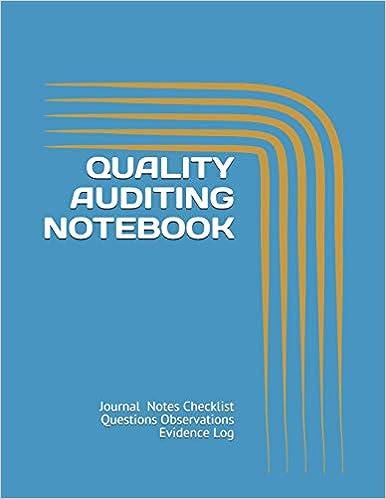Question
Amazon.com Inc. In the past 3 years, Amazon has experienced explosive growth with its stock price rising from around $300 per share in 2015 to
Amazon.com Inc.
In the past 3 years, Amazon has experienced explosive growth with its stock price rising from around $300 per share in 2015 to over $1,000 per share today. With its recent acquisition of Whole Foods Market for $13.7 billion dollars announced on 6/16/2017, Amazon seems to be pushing its boundaries once again beyond an online retail giant, and this time into the brick and mortar grocery business. It will be interesting to see how Amazon is able to re-invent an age old industry of selling groceries while incorporating data and technology into the business.
For this project, I have downloaded from Amazon's website their annual 10K filing with the SEC (Securities Exchange Commission). The SEC requires all public companies to file their annual report with audited financial statements on an annual basis no later than 90 days after its fiscal year end close. Amazon's fiscal year end is 12/31. Thus, this report along with their 12/31/2016 numbers were filed on 2/10/2017. This information is available to the public.
In the attached Excel file, Accounting 2 Financial Statement Analysis Project.xlsx
 you will see six worksheets. Please note that all amounts are in millions (add six zeros to all of the numbers you see). The six worksheets are:
you will see six worksheets. Please note that all amounts are in millions (add six zeros to all of the numbers you see). The six worksheets are:
1. Registration (Why is Amazon Incorporated in the state of Delaware?)
2. Name of the Executive Officers
3. Name of the Board of Directors
4. Consolidated Balance Sheet
5. Consolidated Statement of Operations (same as Income Statement)
6. Consolidated Statement of Cash Flows (which method is this statement prepared under? Direct or Indirect?)
There will be 2 parts to the project; quantitative and qualitative. For all sections, please remember to show work in order to receive full credit. You may either show work via the formula in the Excel cell or if you enter the answers directly into each cell, then type out the actual calculation next to it or type in a general formula/method is fine too. The key is to define the method used in your calculations.
Part 1: Quantitative Analysis (50 points)
Consolidated Balance Sheet
Compute the dollar change and % change from 2015 to 2016. I've started with an example for you in the attached Excel file. You can also refer to page 690-693 of your textbook for a review on how to perform these calculations. (10 points)
Compute the common-size %'s for 2015 and 2016. Again, I've started the first calculations for you as an example. You may refer to page 695-698 in your textbook for reference. (10 points)
Consolidated Income Statement (or Statement of Operations)
Compute the dollar change and % change from 2014 to 2015 and 2015 to 2016. (15 points)
Compute the common-size %'s for 2014, 2015, and 2016 (15 points)
Part 2: Qualitative Analysis (75 points)
Balance Sheet
How are the assets financed in each year? How much (in terms of percentages) by equity and how much by debt (total liabilities)? Hint: Create a subtotal for total liabilities on the balance sheet. After reviewing the percentages, do you think they are moving in a good direction? You may refer to page 797 in your textbook for the Equity ratio and Debt ratio. (5 points)
What are some of the major changes (in terms of assets, liabilities and equity) in 2015 and 2016? In your answer, name at least 3 accounts with the largest % and dollar changes. Be specific in your answer. Quote the actual dollar change amount and percentage change amount and the period affected. (10 points)
Income Statement
1. What is the gross margin for each year? What is the trend you see with gross margin from 2014 to 2016? (5 points)
Hint: Gross margin is calculated by taking:
(Total Net sales - Cost of Sales)/Net Sales
2. What is the profit margin for each year? What is the trend you see with profit margin from 2014 to 2016? (5 points)
Hint: Profit margin is calculated by taking:
Net Income or Net Loss/Net Sales
Profit margin and gross margin are covered on page 797 of your textbook.
3. What are some of the conclusions you can draw from your analysis? For example, do you see any trends from the nets sales mix (for example how much product sales vs. service sales each year and the growth pattern). Also, how is Cost of Sales as a % of Net Sales? Has the number increased or decreased from 2014 to 2015 and 2015 to 2016? For Amazon, which way is better, an increase or a decrease in Cost of Sales as a % of Net Sales? (15 points)
Statement of Cash Flows
1. Calculate Cash Flow on Total Assets for 2016. Refer to page 652 in your textbook for the formula and the definition of this ratio. Explain the ratio you have calculated. What does the ratio mean? (10 points)
2. Name the major uses and sources of cash under the Investing Activities section of the Statement of Cash Flows for each of the year noted. (10 points)
3. Name the major uses and sources of cash under the Financing Activities section of the Statement of Cash Flows for each of the year noted. (10 points)
Overall Conclusion
1. After your analysis, is Amazon a company you would want to invest in? Why or why not? (5 points).
Step by Step Solution
There are 3 Steps involved in it
Step: 1

Get Instant Access to Expert-Tailored Solutions
See step-by-step solutions with expert insights and AI powered tools for academic success
Step: 2

Step: 3

Ace Your Homework with AI
Get the answers you need in no time with our AI-driven, step-by-step assistance
Get Started


